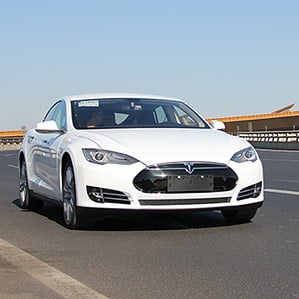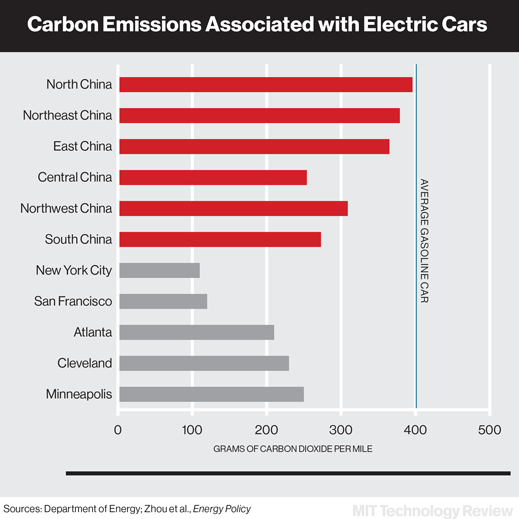Because China relies so heavily on coal for power, electric vehicles aren’t necessarily an improvement over gasoline-powered cars.
- By Mike Orcutt on April 17, 2014
Why It Matters
China, a fast-growing car market, is the world’s largest emitter of carbon dioxide and struggles with urban air pollution.

China-bound: A Tesla Model S sedan.
Sales of electric vehicles in China, the world’s largest auto market, have been minuscule despite government incentives meant to put five million of the cars on the nation’s roads by 2020. Tesla Motors hopes to begin changing that as it makes its first deliveries of Model S sedans to customers in China this month.
But while having more EVs might help China reach its transportation goals, it probably won’t improve the environment, given the country’s reliance on coal for more than 70 percent of its electricity. Making matters worse, coal in China is often dirtier than it is elsewhere, and many power plants don’t employ modern emission-control technologies.
Recent research led by Christopher Cherry, a professor of civil and environmental engineering at the University of Tennessee, has shown that in much of the country, an electric vehicle the size of a Nissan Leaf accounts for roughly the same amount of carbon dioxide per mile driven as a comparable gasoline-powered car. On top of that, EVs in China account for a larger amount of dangerous particulate emissions than conventional cars.
As in the U.S., electricity production in China is cleaner in some places than in others. Whereas northern China relies almost completely on coal plants, a quarter to a third of the power delivered to central and southern regions comes from hydroelectric dams.
Below we compare recent estimates of the greenhouse-gas emissions associated with the production and use of an electric vehicle whose battery and weight are similar to those of the Nissan Leaf. The blue line refers to a similar estimate of the emissions from the average gasoline-powered car in China. For further comparison, we’ve added estimates by the U.S. Department of Energy of emissions by the Leaf in representative U.S. cities. Note that the estimates for the U.S. cities does not account for emissions associated with vehicle production.

Electric vehicles could help clear the air in Chinese cities, many of which have dangerous levels of pollution. Much of that is caused by fine particulate matter emitted from the tailpipes of gas-powered cars. EVs don’t have tailpipes, so replacing gasoline cars with EVs could reduce that pollution.
But this progress would come at a significant environmental cost: higher emissions of particulate matter in rural areas, where most power plants are located. Because burning coal produces far more particulates than burning gasoline, Cherry and his colleagues have found that on average, an EV in China is associated with about 19 times the emissions of fine particulate matter as a comparable gasoline car.
China’s government is aiming to gradually clean up its electric grid by increasing its nuclear capacity in the coming years (see “Nuclear Options”) and aggressively deploying renewables. But recent projections suggest that by 2020, coal’s share will still be as high as 60 percent. The bottom line is that China’s grid, and the EVs that run off it, will be fairly dirty for a long time.

Nenhum comentário:
Postar um comentário
Observação: somente um membro deste blog pode postar um comentário.